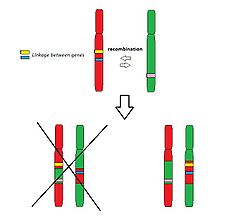Genetic Linkage
Genetic linkage is a connection between different genes, which are located on the same chromosome and influence each other. This relationship was discovered in 1912 by Thomas Hunt Morgan. He took his experiments on fruit flies (Drosophila melanogaster).
Morgan discovered a white eye mutation within D. melanogaster. He found a white-eyed male and crossed it with a wild-type (red-eyed) female. Through this cross, he showed that the mutation is situated on the X chromosome. From the F1 generation came a phenotypically normal female and male. When these were crossed, the F2 generation showed wildtype females, wildtype males, and white-eyed mutant males. This experiment showed that the mutant gene is inherited on the X chromosome from the father.
Gene Connection[edit | edit source]
The proximity of the genes is quite close, but their location on the same chromosome is necessary. This linkage is also important in the process of recombination. It is also used in genetic mapping. The closer the genes on the chromosome are, the stronger genetic linkage occurs. It means that these connected genes are always transmitted together during the meiosis. They don´t assort independently.
Genetic Linkage and Mendel Ratios[edit | edit source]
Genetic linkage is not corresponding with Mendelian ratios. Mendel didn´t find any linkage during his research. Why? The explanation is very easy. He made experiments on pea plants (Pisum sativum). But he examined just 7 genes. These plants have 7 chromosomes at all. So the chance that he could choose two genes in linkage was very small.
Genetic Linkage Analysis[edit | edit source]
It is one of the DNA indirect diagnosis method. It is used, when we are not sure which gene is involved or if the disease is polygenic. How we can then localize the place of our interest? The main role play pedigree (also called “family tree”). All members of family, which is suspected to have any genetic disease, have to be examined. The affected one can have some specific part of DNA in common. This part is usually transmitted through the generations. The healthy relatives should not have this DNA segment. In this case we can attend that the part of DNA is connected with the involved gene.
Links[edit | edit source]
Related articles[edit | edit source]
- Genetic Linkage Analysis
- Meiosis
- Genotype Variation, Mutations and Recombination
- Crossing-over
- Genetic Mapping


